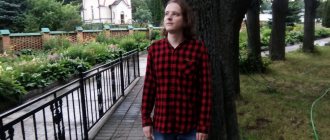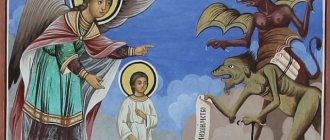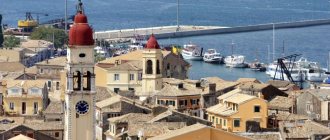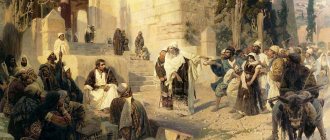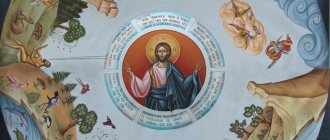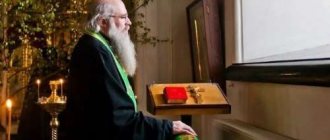The story of Father Nathanael (Pospelov) about the caves created by God
There are 325 slabs in the caves: 220 limestone and 105 ceramic. "Keramos" translated from Greek means "clay".
The day of birth was not written on the slabs, but only the day of death. They adhered to the teachings of the wise Solomon, who wrote that the day of death is better than the day of birth. The first slabs date back to 1559. True, our ancestors calculated chronology from the creation of the world, and this is 5508 years more, that is, the year is 7067.
What do we see on these plates? First of all, in the center of the slab there is a seven-pointed Calvary cross with the city of Jerusalem in the background. Christ deigned to suffer outside the walls of Jerusalem; He suffered for the peoples of the whole world.
On the slab there are inscriptions: monogram of Christ “Is He” - “Jesus Christ Nike (winner); MLRB - “The place of frontal heaven will be fast.”
The cross reminds us that a Christian is buried here, a believer in Christ crucified and risen. Those who do not believe in God are given a five-pointed star on their grave, as a sign that this person perceived the world with five senses and did not recognize what exists beyond the five senses.
The cross on the slab is framed by an arch reminiscent of the Church's Royal Doors - this is a reminder to us that Christ, with His suffering on the cross, opened the doors of heaven to man. The slab also depicts church domes. The history of the Orthodox dome is also complicated. Its shape resembles a drop. A drop, before breaking off, always takes a strictly defined shape, indicating its completeness. So this is exactly the shape of our Orthodox church domes. This testifies that the Church of Christ also has the fullness of grace. The spiers of temples of Western faiths have a sharp spire, that is, they only strive for this.
All the symbolism of the gravestones reminds us of the Roman catacombs, where Christians held services in the first centuries. During times of persecution, they had to switch to symbolic images. Since the symbols of the monogram of Christ in Greek sound like the name of a fish, Christ was symbolically depicted as a fish.
The underground cave temple of the Resurrection of Christ reminds us of the firm belief of our ancestors that just as Christ rose from the dead, so those buried here will rise through the Archangel’s trumpet. And death will not reign in the caves for long, for it has already been defeated by Christ crucified on the cross. That is why the Assumption and Intercession churches, crowned with crosses, stand above the caves.
The caves are the site of the feat of the first monastic ascetics and the monastery’s active cemetery. The belief of the first Christians in the afterlife and their expectation of the general resurrection of the dead prompted them to such an unusual burial, where the bodies of all the brothers would rest until the general resurrection of the dead.
The Church is against cremation, since cremation is a symbol of God's punishment. In the Old Testament there are words: “Your body will not be buried in the ground.” These words were spoken precisely as a threat of punishment.
The Church is also against mummification. This ritual was typical for those pagan times when they did not know the afterlife and mummified the dead in order to “preserve” them.
The Orthodox Church of Christ has no need for such preservation of the body - it believes that the deceased will be resurrected. Some, as the theologian Professor Golubinsky wrote, have zeal beyond reason, thinking that the relics of a saint or righteous person must necessarily be incorruptible. Wrong.
Firstly, the Church calls the body of every Christian after his death relics (which we can see from the breviary); secondly, it must be pointed out that incorruption can be granted to a person who has led an ascetic life only as an additional distinction and benefit. The Church canonizes people not on this basis, but on the basis of those miracles with which the saint of God is glorified.
At the entrance to the caves hangs the icon “The Sign”, or in Greek “Oranta” - Praying. Similar images were in the Roman catacombs. An icon is placed on the chest of the deceased as a sign that the deceased had heartfelt faith in God.
Archimandrite Benedict, who ruled the monastery since 1800, is buried here. Our Pskov land is called the house of the Holy Trinity, and the monastery is the house of the Most Pure Mother of God.
The caves have an underground temple and seven streets. The length of the streets is 217 meters. The temperature in the caves is always constant - plus 5ºС - and one hundred percent humidity. This means that if you place a vessel with water here, not a single drop will be able to evaporate from it.
When the war with Livonia began, military units from Moscow marched through Pskov and Izborsk and entered our monastery as the last border point. They confessed, received communion, listened to a farewell prayer service, took part in the construction of the fortress fence and, of course, asked to remember their souls when the Lord sent a mortal angel for their souls...
Many warriors, benefactors and benefactors of the monastery are buried in the caves. Their wives - Muscovites - considered it their duty to come to us on pilgrimage, to pray for the souls of their husbands, and to make a contribution to the monastery as much as they could.
Among those buried in our caves there are many people from prominent families: Tatishchevs, Elagins, Simanskys (the late Patriarch Alexy I came from this family), Nashchokins, Gagarins, Nazimovs, Neplyuevs, Kropotkins, Chikhachevs, Pushkins...
One of the streets is called Bratskaya because it ends with two fraternal cemeteries. To the right and left along the walls are tombstones.
The soil of the caves is hard sandstone, very beautiful, rich in oxides of various metals. When the city began to think that there were not enough jobs, Father Alypiy suggested that they should use the excellent clays that were in abundance around. It was then that a ceramic factory was built in the city, where many townspeople were able to work.
The slabs in the caves are of different quality, but the oldest, strange as it may seem, are the best preserved. Apparently, this happens according to our usual law: the first product is the highest quality.
The first inhabitants of the monastery, who lived in caves created by God, did not even have good lamps. They used a torch. Therefore, the walls of the caves gradually became covered with soot. The first inhabitants lived poorly, but became spiritually enriched
Brotherly cemeteries: a new cemetery, where ordinary brethren of the monastery have been buried since 1701. In total there are about 400 coffins. The old cemetery, where burials took place before 1700.
The Church of the Resurrection of Christ was built in caves by the founders of our monastery. By this they expressed the belief that just as Christ was resurrected, so every person will be resurrected. Church of the Resurrection. The style of the iconostasis is the style of Greek churches. Here, according to his own will, our ever-memorable governor, Father Alypius, is buried. And next to him is his right hand, the housekeeper, Archimandrite Father Irenaeus.
The tombstones in the caves are not the same. Art has changed from century to century. But the best - both in terms of aesthetics and quality of execution - are the ancient ones.
Our Holy Dormition Pskov-Pechersky first-class monastery is an ancient and revered monastery in Rus'. She is known for her unforgettable services to the Church and the Fatherland.
The first elders of the desert, as we believe, were either from the cenobitic monasteries of Pskov, or from the Kyiv caves, pressed by the Tatars. The elders could not go further west - three miles away was the border of the German Teutonic Order. In addition, they found caves here ready for life. The first elders, having built a dwelling and a temple in caves, lived in obscurity. Everything old and good was born in the unknown. But then gradually it became known.
So two Izborsk residents, father and son, were hunting in these places and in the morning, where the Assumption Church is now, they heard wonderful singing and felt a fragrance. Not knowing the true reason for the fragrance and singing, they took it for the appearance of angels. On the advice of other residents of Izborsk, they bought this place from the Pskov residents. And by lot this place went to the peasant Ivan Dementyev. One day he cut down an old tree above the caves. It fell, knocked down a number of trees, tore out a piece of earth, and the mouth opened. And there was an inscription “Entrance to the caves created by God.”
At this time, among Russian monasticism there was a desire to move away from crowded cities to deserted places. This is how the north was developed, and this was also the case in the north-west of Russia.
From the book “Novice of the Mother of God Monastery”
History, Caves, Report
Border Monastery
The monks chose a strange location to build the monastery. Where have you seen a monastery not standing on a hill, but sliding into a deep ravine? The place is strange, but very strategic. Exactly in the middle between Moscow and the Livonian Order.
Therefore, high stone fortress walls with seven towers and three gates were built in 1558-1565 and more than once played an important role in history, protecting the Pechersky Monastery from the Livonian fortress of Neuhausen, located just 20 kilometers away.
The fortress withstood a two-month siege by a detachment of troops of the Polish king Stefan Batory and a Hungarian detachment in 1581, other Polish detachments, Swedish troops (with interruptions in 1611-1614), troops of the Swedish king Charles XII (1703). The fortress walls of the monastery served for defense for more than 150 years until the end of the Northern War and the conclusion of the Nystadt Peace. They also withstood fascist bombs in the 20th century.
Rarely does anyone call a monastery a fortress. But the total length of its unusual stepped walls exceeds 700 meters. The high walls of the Pechersk fortress go along the slope of a deep ravine, at the bottom of which the Kamenets stream flows.
And seven towers, Ostrozhnaya-tower of the Lower Grates-Blagoveshchenskaya-Izborskaya-Tararygina-tower of the Upper Grids-Taylovskaya, reliably protect the perimeters.
The most interesting are the two towers at the very bottom of the ravine - the Lower Lattice Tower and the Upper Lattice Tower. Two slender square towers are located opposite each other. In their lower part there are small stone arches, through which the waters of the stream enter the fortress, continue their flow and flow out from the other side. These arches are covered with iron bars to prevent the besiegers from using the stream to penetrate the fortress. The lattice gave the name to the towers.
In addition, the tower of the Upper Grilles is also the tallest in the fortress complex. Its height is 25 meters, so it hardly sags compared to other towers, despite the fact that it is located in the lowest place. The tower has a guard hut, chambers for installing guns and a lookout platform from which all the surroundings of Pechory are perfectly visible.
The monastery that never closed
And this is no longer a legend, but a fact. Over 550 years of history, the monastery was destroyed more than once, but neither wars, nor the alienation of lands in favor of different states, nor rulers could close it.
After destruction, the monastery was always restored and received another feat of arms to add to history. And the brethren not only participated in protection and restoration, but always helped parishioners in trouble.
During the Livonian War they carried out missionary activities. They founded churches in the conquered areas, provided assistance to the victims, and the names of those killed in the war were entered into the monastery synodik for commemoration. During the German occupation, the brethren of the monastery participated in the Pskov Orthodox mission , which revived spiritual life in the occupied territories.
State borders moved, but did not disturb the monastic peace. But the Soviet government decided to seriously address the issue of unquenchable faith in the Pskov region.
Various commissions visited the monastery repeatedly, with the sole purpose of closing the monastery. Once again the commission arrived, this time with a closure order. But its abbot Alypius only glanced at the papers and immediately threw them into the burning fireplace. No papers - no reason to close.
Before the next commission, the monastery gates were simply closed. And Alypiy said that the monastery had preserved a lot of weapons from the times of the war and many of the brethren were front-line soldiers who would fight to the last. Alypiy further said that it would be possible to take the monastery only with the help of aviation, which would certainly be reported on by the Voice of America.
They say that after this, even the Soviet government abandoned all attempts to close the Pechersky Monastery.
